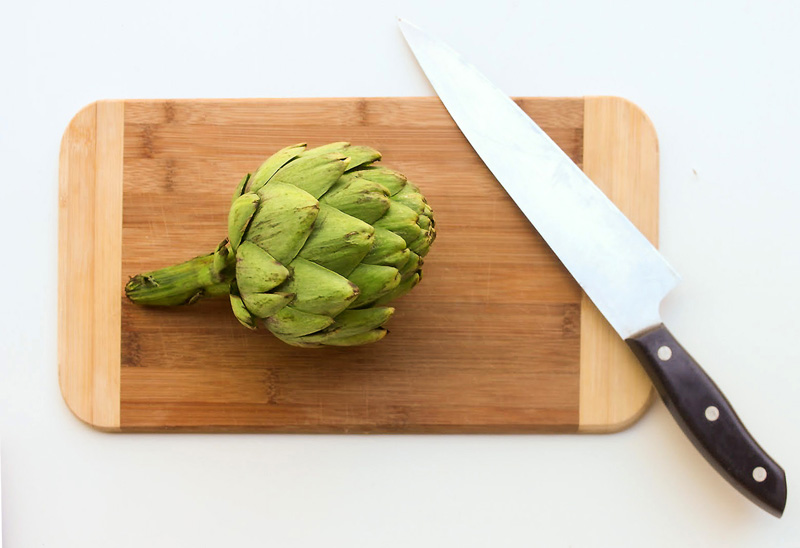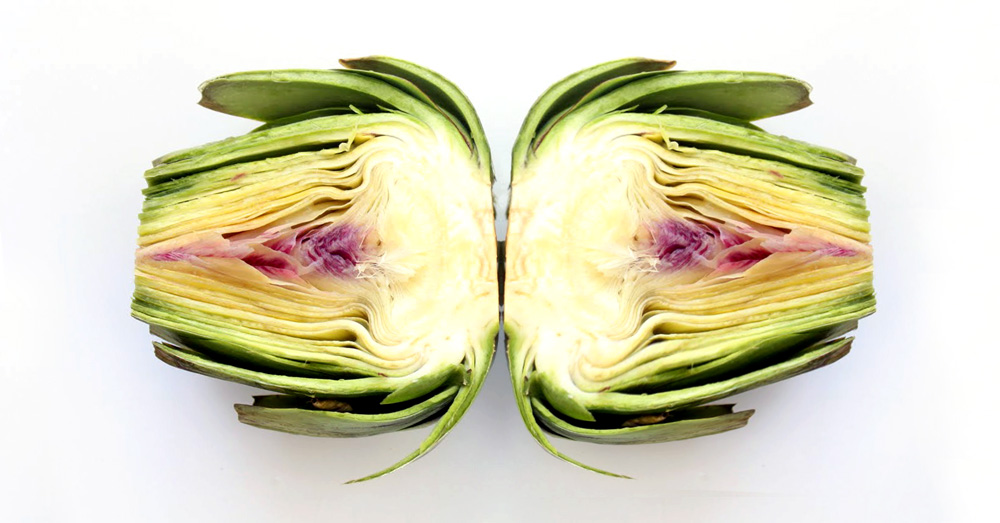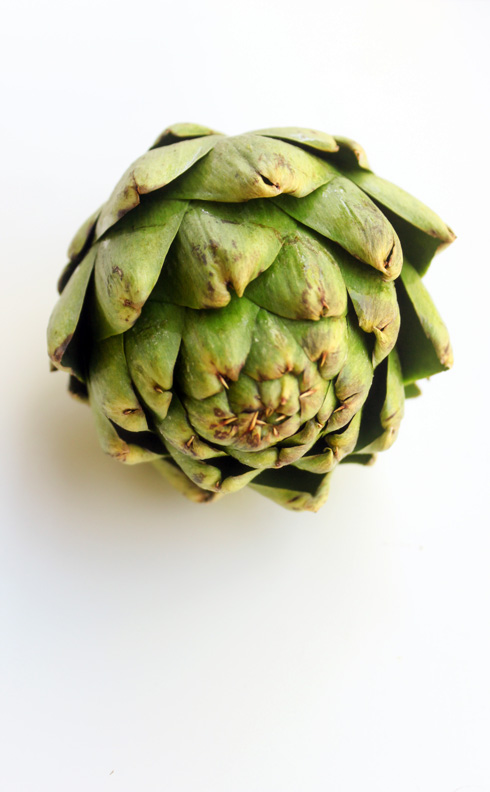

In all honesty, if your recipe calls for just artichoke hearts, such as in an artichoke dip, then it might be better to just get the pre-cut ones from a jar, but if you like a bit of a challenge and are yearning to look at something new when you open your fridge, it might just be the perfect match.
Meet the artichoke: it has had a turbulent history. Few may know that during the 16th century these thorny veggies were considered scandalous for women to eat as they were believed to enhance sexual power. The trouble continued in the 1920s when a mafia member known as the “Artichoke King” developed an artichoke monopoly by terrorizing distributors and merchants alike. He even went as far as destroying entire crops in California from Montara to Pescadero in the dead of night, escalating the situation into a full on “Artichoke War”. This resulted in Mayor LaGuardia declaring them illegal in New York City (although that only lasted a week; the mayor was too big of an artichoke fan). As if scandal and legal problems weren’t enough of a rocky upbringing, history shows that artichokes have had a tough time reaching the masses as they were seen to be exclusive, expensive and, in many countries, reserved for aristocracy. Today, they are widely available and yet, still largely overlooked. Why?
Well for starters, you’ve probably avoided buying whole artichokes because of their intimidating appearance; it just has “failure” written all over it. They are scary-looking and seem like a lot of effort. And why go through that effort when you can buy delicious artichoke hearts all ready for you in a jar? We’ve all been there, but it’s actually really easy to prep them; a little patience goes a long way.
What Is It
A flower bud that is a member of the thistle family, the artichoke is known most commonly for its heart. To give you a quick anatomy lesson: the artichoke has tough outer leaves, with softer purple tipped ones hidden inside, and below those leaves is the heart. The heart is covered by what is called the choke; it’s the fuzzy stuff on top and is not something you want to eat.

Why we love it
Artichokes can be steamed, stuffed, grilled, braised, roasted and sautéed. When pruned to reveal the heart, they can also be made into a salad, a stew, soup or fries (just to name a few options). They are like a treasure hunt: there’s a bit of work required along the way, but the prize you’re looking for is hiding in the middle, and you can eat your way straight to the heart (how romantic).
For our health conscious readers and all the people out there searching for the next miracle “superfood”, you might want to know that artichokes are very nutritious and a lot of those nutrients live in the leaves. A natural antioxidant that boosts your immune system and lowers cholesterol, one medium artichoke has about 65 calories and is high in fibre, potassium and Vitamin C.
How to pick one
There are a few ways to tell if you’re taking home the best of the bunch: look for an artichoke with a vibrant healthy green shade and tightly compacted leaves; firmness and weight are indications that the artichoke is not dehydrated. Rubbing the outer leaves and listening for squeaking noises will also indicate if the ‘choke is holding the right amount of moisture. Bending the leaf will indicate its freshness; if it’s fresh, it will snap off quickly.
How to prep
The heart of the Artichoke
Once you get it home, rinse the artichoke thoroughly. Watch out for your hands; those little thorns pinch.
The amount of stem taken off depends on how you will be preparing the artichoke. It is always best to cut close to the base allowing the artichoke to stand flat on a surface.
Starting from the outside and working your way in, pull off the artichoke leaves (this may take a while but don’t give up!)
Beneath the tough green leaves there will be soft pale green ones with purple tips; rip those off as well. Once you’ve peeled your way to the centre, there is an inedible, fibrous part (called the “choke”), so be sure to scoop that out with a spoon.
Using a spoon, scrape all of the choke out, making sure to leave nothing but the heart.
Using a knife, get rid of any extra tough green parts surrounding the artichoke stem and heart. Now it should be clean and smooth.
You will then find your veggie now looks like a 20K diamond. Success, you have exposed the heart.
A whole artichoke
Rinse the artichoke thoroughly being sure to wash between all the leaves without ripping them.
Cut off the top five centimeters of the vegetable where the leaves are most tightly bunched.
Trim the remaining thorns off the rest of the artichoke.
Cut off the stem at the bottom of the artichoke so that it can stand flat on a surface.
How to cook
Boil
Bring a pot of water to a boil. Boil the artichoke for about 20-40 minutes depending on the size of your artichoke. Add a bit of lemon juice or vinegar to your water to avoid the artichoke becoming discoloured. To cut down on cooking time, the artichoke can be cut into quarters and boiled for 20 minutes – provided you are not planning on stuffing it.
Steam
It can also be steamed until tender, which takes about 30-45 minutes. If you are not planning to eat the artichoke right away, spritz it with lemon juice, otherwise it will quickly discolour.
Stuff
Cut off the prickly parts of the leaves and take off all of the hardest outside leaves. Next, gently push back the outer leaves to dig out the the middle and the choke (that hairy part) and clean until all sides are smooth. You can then stuff it with just about anything: sausage and breadcrumbs, cheese and garlic—anything you think tastes nice together will probably work perfectly inside the artichoke. Once it’s stuffed, bake at 400F for about an hour to 90 minutes, until it’s tender. Volia!

How to eat it
Knowing how to prune and core an artichoke is the primary technique for most recipes, and although it might call for just the heart, you can actually eat your way there.
Rip the petal off by pulling down and away from the centre and remove the soft flesh that’s at the bottom of the petal by pulling it through clenched teeth. Have a bowl nearby for the remainder (it’s like vegetarian wings). They taste great dipped into just about any sauce: garlic aioli, butter and garlic, butter and lemon, pretty much anything and butter.
How to store it
When you first get them home from the market, slice off a small end of the stem, sprinkle a bit of water on top and put them in an air-tight bag; they’ll keep this way for about a week after you buy them. Once cooked, the artichoke will keep in the fridge for up to a week, just be sure they are completely cooled and well covered before putting them away.
There you have it
So, when it’s broken down like that, they don’t really seem that bad, right?

In all honesty, if your recipe calls for just artichoke hearts, such as in an artichoke dip, then it might be better to just get the pre-cut ones from a jar, but if you like a bit of a challenge and are yearning to look at something new when you open your fridge, it might just be the perfect match.
Meet the artichoke: it has had a turbulent history. Few may know that during the 16th century these thorny veggies were considered scandalous for women to eat as they were believed to enhance sexual power. The trouble continued in the 1920s when a mafia member known as the “Artichoke King” developed an artichoke monopoly by terrorizing distributors and merchants alike. He even went as far as destroying entire crops in California from Montara to Pescadero in the dead of night, escalating the situation into a full on “Artichoke War”. This resulted in Mayor LaGuardia declaring them illegal in New York City (although that only lasted a week; the mayor was too big of an artichoke fan). As if scandal and legal problems weren’t enough of a rocky upbringing, history shows that artichokes have had a tough time reaching the masses as they were seen to be exclusive, expensive and, in many countries, reserved for aristocracy. Today, they are widely available and yet, still largely overlooked. Why?
Well for starters, you’ve probably avoided buying whole artichokes because of their intimidating appearance; it just has “failure” written all over it. They are scary-looking and seem like a lot of effort. And why go through that effort when you can buy delicious artichoke hearts all ready for you in a jar? We’ve all been there, but it’s actually really easy to prep them; a little patience goes a long way.
What Is It
A flower bud that is a member of the thistle family, the artichoke is known most commonly for its heart. To give you a quick anatomy lesson: the artichoke has tough outer leaves, with softer purple tipped ones hidden inside, and below those leaves is the heart. The heart is covered by what is called the choke; it’s the fuzzy stuff on top and is not something you want to eat.

Why we love it
Artichokes can be steamed, stuffed, grilled, braised, roasted and sautéed. When pruned to reveal the heart, they can also be made into a salad, a stew, soup or fries (just to name a few options). They are like a treasure hunt: there’s a bit of work required along the way, but the prize you’re looking for is hiding in the middle, and you can eat your way straight to the heart (how romantic).
For our health conscious readers and all the people out there searching for the next miracle “superfood”, you might want to know that artichokes are very nutritious and a lot of those nutrients live in the leaves. A natural antioxidant that boosts your immune system and lowers cholesterol, one medium artichoke has about 65 calories and is high in fibre, potassium and Vitamin C.
How to pick one
There are a few ways to tell if you’re taking home the best of the bunch: look for an artichoke with a vibrant healthy green shade and tightly compacted leaves; firmness and weight are indications that the artichoke is not dehydrated. Rubbing the outer leaves and listening for squeaking noises will also indicate if the ‘choke is holding the right amount of moisture. Bending the leaf will indicate its freshness; if it’s fresh, it will snap off quickly.
How to prep
The heart of the Artichoke
Once you get it home, rinse the artichoke thoroughly. Watch out for your hands; those little thorns pinch.
The amount of stem taken off depends on how you will be preparing the artichoke. It is always best to cut close to the base allowing the artichoke to stand flat on a surface.
Starting from the outside and working your way in, pull off the artichoke leaves (this may take a while but don’t give up!)
Beneath the tough green leaves there will be soft pale green ones with purple tips; rip those off as well. Once you’ve peeled your way to the centre, there is an inedible, fibrous part (called the “choke”), so be sure to scoop that out with a spoon.
Using a spoon, scrape all of the choke out, making sure to leave nothing but the heart.
Using a knife, get rid of any extra tough green parts surrounding the artichoke stem and heart. Now it should be clean and smooth.
You will then find your veggie now looks like a 20K diamond. Success, you have exposed the heart.
A whole artichoke
Rinse the artichoke thoroughly being sure to wash between all the leaves without ripping them.
Cut off the top five centimeters of the vegetable where the leaves are most tightly bunched.
Trim the remaining thorns off the rest of the artichoke.
Cut off the stem at the bottom of the artichoke so that it can stand flat on a surface.
How to cook
Boil
Bring a pot of water to a boil. Boil the artichoke for about 20-40 minutes depending on the size of your artichoke. Add a bit of lemon juice or vinegar to your water to avoid the artichoke becoming discoloured. To cut down on cooking time, the artichoke can be cut into quarters and boiled for 20 minutes - provided you are not planning on stuffing it.
Steam
It can also be steamed until tender, which takes about 30-45 minutes. If you are not planning to eat the artichoke right away, spritz it with lemon juice, otherwise it will quickly discolour.
Stuff
Cut off the prickly parts of the leaves and take off all of the hardest outside leaves. Next, gently push back the outer leaves to dig out the the middle and the choke (that hairy part) and clean until all sides are smooth. You can then stuff it with just about anything: sausage and breadcrumbs, cheese and garlic—anything you think tastes nice together will probably work perfectly inside the artichoke. Once it’s stuffed, bake at 400F for about an hour to 90 minutes, until it’s tender. Volia!

How to eat it
Knowing how to prune and core an artichoke is the primary technique for most recipes, and although it might call for just the heart, you can actually eat your way there.
Rip the petal off by pulling down and away from the centre and remove the soft flesh that’s at the bottom of the petal by pulling it through clenched teeth. Have a bowl nearby for the remainder (it’s like vegetarian wings). They taste great dipped into just about any sauce: garlic aioli, butter and garlic, butter and lemon, pretty much anything and butter.
How to store it
When you first get them home from the market, slice off a small end of the stem, sprinkle a bit of water on top and put them in an air-tight bag; they’ll keep this way for about a week after you buy them. Once cooked, the artichoke will keep in the fridge for up to a week, just be sure they are completely cooled and well covered before putting them away.
There you have it
So, when it’s broken down like that, they don’t really seem that bad, right?
